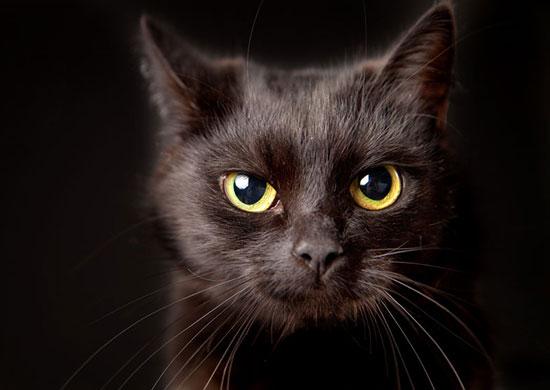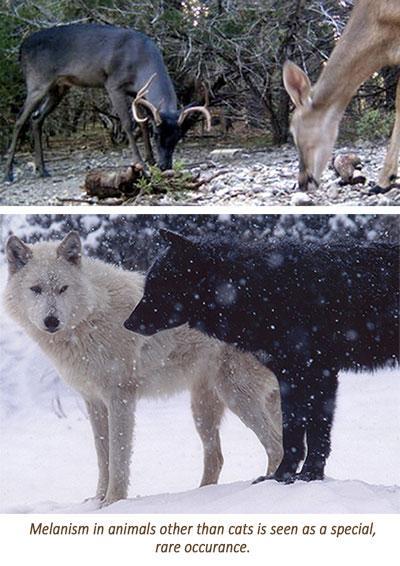This content is archived from the Feline Nutrition Foundation
Black Cats Are Not Unlucky at All
- Updated: Sunday, May 26, 2019 03:46 PM
- Published: Monday, January 04, 2010 11:50 AM
- Written by Margaret Gates
 When you start feeding raw food for cats, you begin to ask questions. For so many years, I fed dry, plant-based kibble because I had never asked those questions. It was a shock to realize how much I had taken for granted. I never asked myself the "why" of what I was doing.
When you start feeding raw food for cats, you begin to ask questions. For so many years, I fed dry, plant-based kibble because I had never asked those questions. It was a shock to realize how much I had taken for granted. I never asked myself the "why" of what I was doing.
It's clear now it's always good to ask questions about all those reasons why. Questioning things we accept as given can lead us to interesting places. We should be more like children when we ask questions. They ask about things adults have stopped noticing. A child will ask, "Why is the sky blue?" As adults we think, well, just because it is, that's why – if we think about it all. We take it for granted that it's blue. Always has been, right? But answering that question leads us into some basic science about chemistry, physics and the behavior of light.
Recently, I asked one of those kind of questions: Why are there so many black cats?
Black-colored fur is a naturally occurring mutation in many cat species. Of the 37 felidae species, eleven express the black gene mutation.¹ These include the domestic cat, leopard, cheetah, jaguar, caracal, serval, jaguarundi, lynx, bobcat, Scottish wild cat and Geoffroy's cat. This mutation is called melanism. It appears less commonly in other animals, and it's noticed. But people don't think twice about our cats being black.
As it turns out, there may be a good reason so many cats are black. A study conducted at the National Cancer Institute reveals that melanism developed independently at least four different times, using different gene mutations, among the different cat species.² The mutations for melanism in jaguars and jaguarundis occur in the same gene, MC1R. It belongs to a family of genes that code for receptors that stud cell surfaces. In humans, these receptors are used by certain viruses, including HIV, to break into cells. People with mutations in these receptors are far less likely to become infected with HIV than those with normal versions. Because of this similarity, it's theorized the melanism mutation in cats may give them protection from some viral infections.³
 The melanism mutation in domestic cats is a two base pair deletion on the ASIP gene. It is the agouti gene, which controls color banding on the hair shaft.⁴ With resistance to some viral infections as a side effect, having a black coat can increase the chances for survival, as well as the chances of passing the black fur mutation to offspring.
The melanism mutation in domestic cats is a two base pair deletion on the ASIP gene. It is the agouti gene, which controls color banding on the hair shaft.⁴ With resistance to some viral infections as a side effect, having a black coat can increase the chances for survival, as well as the chances of passing the black fur mutation to offspring.
What started as a chance mutation becomes an evolutionary advantage.
This makes me curious as to whether black cats in the present have a lower incidence of feline viral infections, such as FIV and FeLV. Are black cats more common in feral colonies? Might they have an advantage in resisting the infections so common in large groups of outdoor felines? The NCI scientists were so intrigued by the results of their work that a study as to whether black cats were more resistant or immune to FIV was contemplated.⁵
Additional Reading
What Bob Dole Taught Me About Raw Food
So, the next time a black cat crosses your path, think, there goes one lucky cat!
Margaret Gates is the founder of the Feline Nutrition Foundation.
1. E. Eizirik, N. Yuhki, W. E. Johnson, M. Menotti-Raymond, S. S. Hannah, and S. J. O'Brien, "Molecular Genetics and Evolution of Melanism in the Cat Family," Current Biology 13, March 4, 2003, 448-453.
2. Adam Marcus, "Black Cats and Genomics Cross Paths," Genome News Network, March 21, 2003.
3. Marcus, "Black Cats."
4. E. Eizirik, N. Yuhki, W. E. Johnson, M. Menotti-Raymond, S. S. Hannah, and S. J. O'Brien, "Molecular Genetics and Evolution of Melanism in the Cat Family," Current Biology 13, March 4, 2003, 448-453.
5. Adam Marcus, "Black Cats and Genomics Cross Paths," Genome News Network, March 21, 2003.




